|

Instructions
Contents
You can help control your blood sugar (also called blood glucose)
and diabetes when you eat healthy, get enough exercise, and
stay at a healthy weight.
A healthy weight also helps you control your blood fats
and lower your blood pressure.
Many people with diabetes also need to take medicine to
help control their blood sugar.
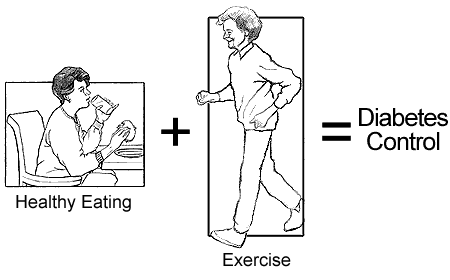
Using the food pyramid helps you eat a variety of healthy
foods. When you eat different foods, you get the vitamins
and minerals you need.
 Eat different foods from each group each day. See how to
do this in the example below.
Eat different foods from each group each day. See how to
do this in the example below.
|
Day
1 |
Day
2 |
| Fruit: |
apple
orange |
banana
mango |
| Vegetable: |
broccoli |
salad
green beans |
|
Starches are bread, grains, cereal, pasta, or starchy vegetables.
Eat some starches at each meal. People might tell you not
to eat many starches, but that is no longer correct advice.
Eating starches is healthy for everyone, including people
with diabetes.
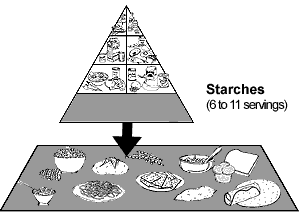
The number of servings you should eat each day depends
on
- The calories you need.
- Your diabetes treatment plan.
Starches give your body energy, vitamins and minerals,
and fiber. Whole grain starches are healthier because they
have more vitamins, minerals, and fiber. Fiber helps you
have regular bowel movements.
How Much Is a Serving of Starch?
1 Serving:

2 Servings:

3 Servings:

You might need to eat one, two, or three starch servings
at a meal. If you need to eat more than one serving at a
meal, choose several different starches or have two or three
servings of one starch.
What Are Healthier Ways to Buy, Cook, and Eat Starches?
- Buy whole grain breads and cereals.
- Eat fewer fried and high-fat starches such as regular
tortilla chips and potato chips, french fries, pastries,
biscuits, or muffins.
- Use low-fat or fat-free yogurt or fat-free sour cream
instead of regular sour cream on a baked potato.
- Use mustard instead of mayonnaise on a sandwich.
- Use the low-fat or fat-free substitutes such as low-fat
mayonnaise or light margarine on bread, rolls, or toast.
- Use vegetable oil spray instead of oil, shortening,
butter, or margarine.
- Cook or eat cereal with fat-free (skim) or low-fat (1%)
milk.
- Use no-sugar jelly, low-fat or fat-free cottage cheese,
nonfat yogurt, or salsa.
Vegetables are healthy for everyone, including people with
diabetes. Eat raw and cooked vegetables every day. Vegetables
give you vitamins, minerals, and fiber, with very few calories.
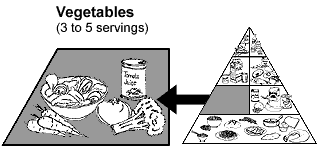
The number of servings you should eat each day depends
on
- The calories you need.
- How you take care of your diabetes.
How Much Is a Serving of Vegetables?
1 Serving:
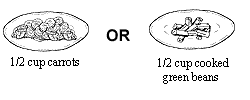
2 Servings:

3 Servings:

You might need to eat one, two, or three vegetable servings
at a meal. If you need to eat more than one serving at a
meal, choose a few different types of vegetables or have
two or three servings of one vegetable.
What Are Healthier Ways To Buy, Cook, and Eat Vegetables?
Eat raw and cooked vegetables with little or no fat. You can
cook and eat vegetables without any fat.
- Try low-fat or fat-free salad dressing on raw vegetables
or salads.
- Steam vegetables using a small amount of water or low-fat
broth.
- Mix in some chopped onion or garlic.
- Use a little vinegar or some lemon or lime juice.
- Add a small piece of lean ham or smoked turkey.
- Sprinkle with herbs and spices. These flavorings add
almost no fat or calories.
If you do use a small amount of fat, use canola oil, olive
oil, or tub margarine instead of fat from meat, butter,
or shortening.
Fruit is healthy for everyone, including people with diabetes.
Fruit gives you energy, vitamins and minerals, and fiber.
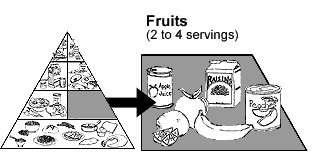 The number of servings you should eat each day depends on
The number of servings you should eat each day depends on
- The calories you need.
- How you take care of your diabetes.
How Much Is a Serving of Fruit?
1 Serving:
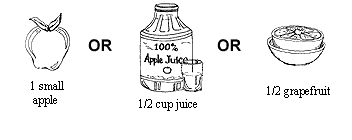
2 Servings:
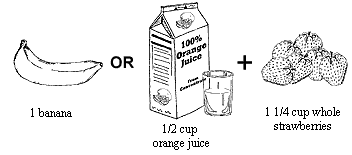
You might need to eat one or two fruit servings at a meal.
If you need to eat more than one serving at a meal, choose
different types of fruits or have two servings of one fruit.
How Should I Eat Fruit?
Eat fruits raw, as juice with no sugar added, canned in their
own juice, or dried.
- Buy smaller pieces of fruit.
- Eat pieces of fruit rather than drinking fruit juice.
Pieces of fruit are more filling.
- Buy fruit juice that is 100-percent juice with no added
sugar.
- Drink fruit juice in small amounts.
- Save high-sugar and high-fat fruit desserts such as
peach cobbler or cherry pie for special occasions.
Fat-free and low-fat milk and yogurt are healthy for everyone,
including people with diabetes. Milk and yogurt give you energy,
protein, calcium, vitamin A, and other vitamins and minerals.
Drink fat-free (skim or nonfat) or low-fat (1%) milk each
day. Eat low-fat or fat-free yogurt. They have less total
fat, saturated fat, and cholesterol.
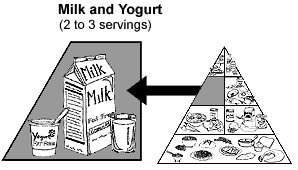
The number of servings you should eat each day depends
on
- The calories you need.
- How you take care of your diabetes.
Note: If you are pregnant or breastfeeding, eat
four to five servings of milk and yogurt each day.
How Much Is a Serving of Milk and Yogurt?
1 Serving:
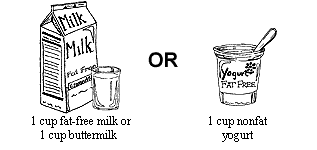
Protein foods are meat, poultry, eggs, cheese, fish, and tofu.
Eat small amounts of some of these foods each day.
Protein foods help your body build tissue and muscles.
They also give your body vitamins and minerals.
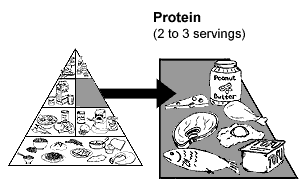
The number of servings you should eat each day depends
on
- The calories you need.
- How you take care of your diabetes.
How Much Is a Serving of Protein Food?
1 Serving:

The serving size you eat now may be too big.
One serving should weigh between 2 and 3 ounces after cooking,
about the size of a deck of cards.
What Are Healthier Ways To Buy, Cook, and Eat Protein
Foods?
- Buy cuts of beef, pork, ham, and lamb that have only
a little fat on them. Trim off extra fat.
- Eat chicken or turkey without the skin.
- Cook protein foods in low-fat ways:
- Broil.
- Grill.
- Stir-fry.
- Roast.
- Steam.
- Stew.
- To add more flavor, use vinegars, lemon juice, soy or
teriyaki sauce, salsa, ketchup, barbecue sauce, and herbs
and spices.
- Cook eggs with a small amount of fat.
- Eat small amounts of nuts, peanut butter, fried chicken,
fish, or shellfish. They are high in fat.
You find the fats and oils section at the tip of the pyramid.
This tells you to eat small amounts of fats and oils because
they have lots of calories. Some fats and oils also contain
saturated fats and cholesterol that are not good for you.
You also get fat from other foods such as meats and some
dairy foods.
High-fat food is tempting. But eating small amounts of
high-fat food will help you lose weight, keep your blood
sugar and blood fats under control, and lower your blood
pressure.
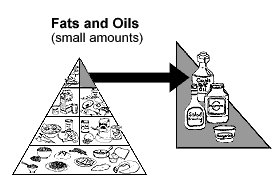
How Much Is a Serving of Fat or Oil?
1 Serving:
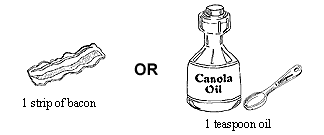
2 Servings:

Your meals may include one or two servings of fat.
You find the sugary foods and sweets section at the tip of
the pyramid. This tells you to eat small amounts of sugary
foods.
Sugary foods have calories and do not have much nutrition.
Sugary foods have lots of calories. Some sugary foods are
also high in fat--like cakes, pies, and cookies. They also
may contain saturated fats and cholesterol.
Sugary foods and sweets are tempting. But eating small
amounts of sugary foods will help you lose weight, keep
your blood sugar under control, control your blood fats,
and lower your blood pressure.
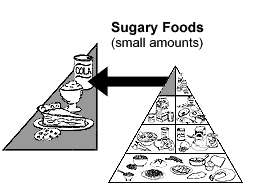
How Much Is a Serving of Sugary Foods and Sweets?
1 Serving:
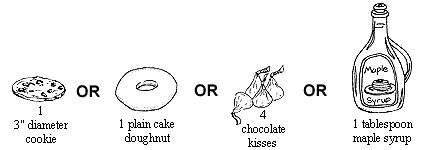
Once in a while you can eat a serving of a sugary food.
Talk to your diabetes teacher about how to fit sugary foods
into your meal plan.
How Can I Satisfy My Sweet Tooth?
Eat a serving of sugar-free popsicles, diet soda, fat-free
ice cream or yogurt, or sugar-free hot cocoa mix once in a
while.
Remember, fat-free and low-sugar foods still have some
calories. Eat them as part of your meal plan.

To follow a healthy eating plan
- Choose foods from all six food groups each day.
- Eat a wide variety of foods from each group to get all
your vitamins and minerals.
- Eat enough starches, vegetables, fruits, and low-fat
milk and yogurt.
- Eat smaller amounts of lower fat protein foods.
- Eat fewer fats, oils, and sugary foods.
Diabetes Teachers (nurses, dietitians, pharmacists,
and other health professionals)
- To find a diabetes teacher near you, call the American
Association of Diabetes Educators toll-free at 1-800-TEAMUP4
(1-800-832-6874).
Recognized Diabetes Education Programs
(teaching programs approved by the American Diabetes Association)
- To find a program near you, call 1-800-DIABETES (1-800-342-2383)
or look at its Internet home page http://www.diabetes.org/ and click
on "Diabetes Info."
 Dietitians Dietitians
- To find a dietitian near you, call The American Dietetic
Association's National Center for Nutrition and Dietetics
at 1-800-366-1655 or look at its Internet home page http://www.eatright.org/ and click
on "Find a Dietitian."
Two other booklets can help you learn more about food and
diabetes:
For free copies of these booklets:

The individuals listed here provided editorial guidance or
facilitated field testing for this publication. The National
Diabetes Information Clearinghouse would like to thank these
individuals for their contributions.
American Association
of Diabetes Educators
Chicago, IL
Shelly Amos, L.R.D. Nez PercÚ Nutrition
Lapwai, ID
Noreen Cohen, M.S., R.D., L.D. Humana
Health Care Plans
San Antonio, TX
Paula Dubcak, R.N., C.D.E. Humana
Health Care Plans
San Antonio, TX
Lois Exelbert, R.N., M.S., C.D.E.,
A.C.C.E.
Joslin Center for Diabetes
Baptist Hospital of Miami
Miami, FL
|
Ruth Farkas-Hirsch,
R.N., M.S., C.D.E. (on behalf of American Diabetes Association)
University of Washington, Diabetes Care Center
Seattle, WA
Lawana Geren, R.N., C.D.E.
Humana Health Care Plans
San Antonio, TX
Gwen Hosey, M.S., A.N.P., C.D.E.
IHS Portland Area Diabetes Program at Washington
Bellingham, WA
Joslin Center for Diabetes
Community Medical Center
Toms River, NJ
Melinda Maryniuk, M.Ed., R.D., C.D.E.
Joslin Diabetes Center
Boston, MA
|
Pat Mathis,
M.S., R.N., C.D.E.
Marianne Sack, R.N., C.D.E.
So Others Might Eat
Washington, DC
Kathy O'Keeffe, M.S., R.D., L.D.,
C.D.E.
Carolina Diabetes and Kidney Center
Sumter, SC
Carolyn Ross, R.D., M.S., C.D.E.
PHS Indian Hospital
Cass Lake, MN
Lisa Spence, M.S.
Purdue University
West Lafayette, IN
Judy Tomassene, M.P.H., M.S., R.D.
Seattle Indian Health Board
Seattle, WA
Madelyn L. Wheeler, M.S., R.D., F.A.D.A.,
C.D.E.
Indiana University School of Medicine Diabetes Research
and Training Center
Indianapolis, IN
|
|